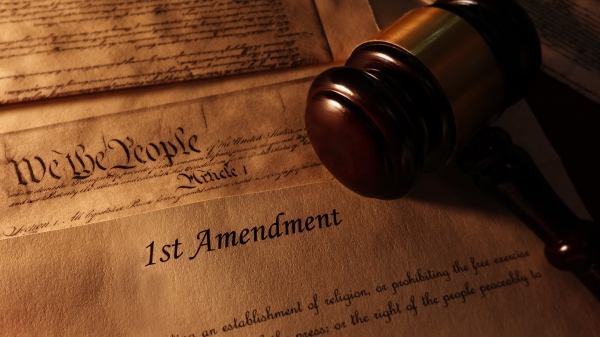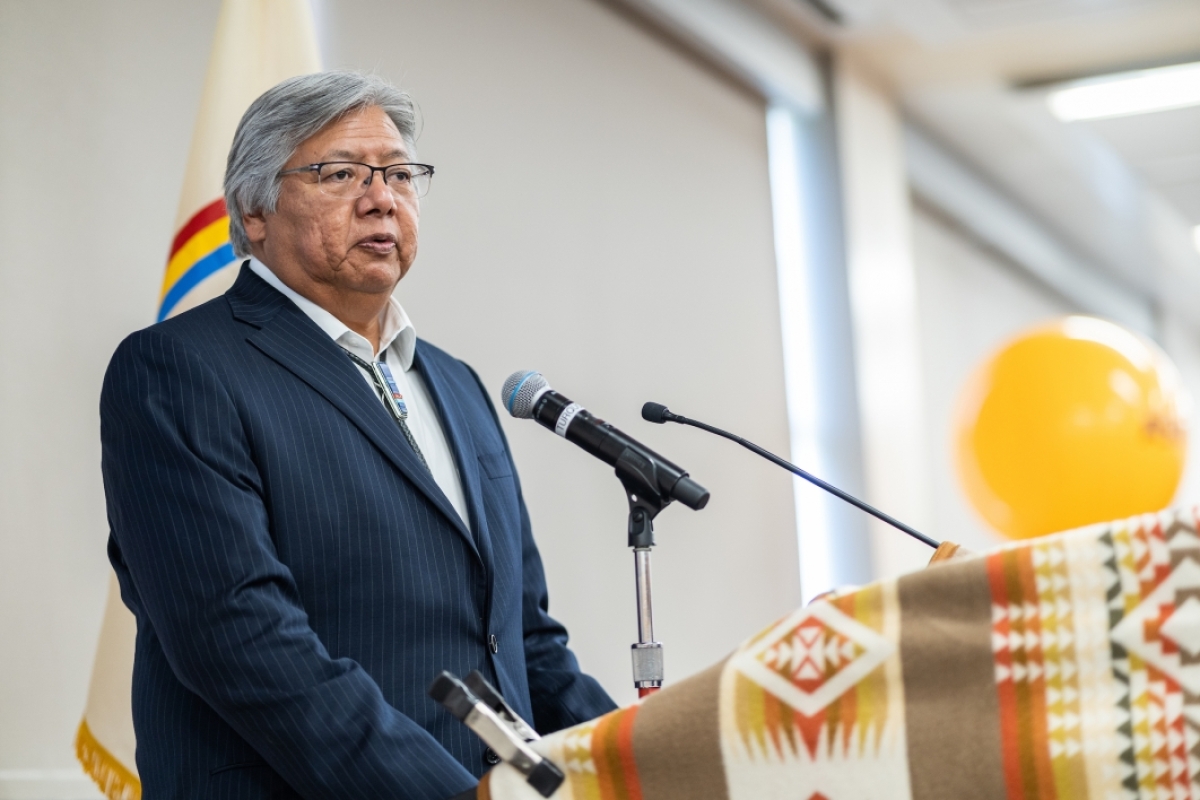Peterson Zah's life, impact remembered at celebration of life on ASU campus

Bryan Brayboy, senior advisor to the president on American Indian affairs at ASU, speaks about Peterson Zah during the April 25 celebration of life at the Memorial Union in Tempe. The event honored the first president of the Navajo Nation and a graduate of ASU who died March 7 at age 85. Photo by Alwaleed Alrasbi/ASU
Editor’s note: This story is featured in the 2023 year in review.
Peterson Zah was remembered Tuesday as a visionary leader who not only helped to shape Arizona State University to be more inclusive but also laid the groundwork for the future of the Navajo Nation.
Zah was the first president of the Navajo Nation and a graduate of Arizona State University. The celebration of life held for him at the Memorial Union on the Tempe campus drew family, friends, state leaders, Zah’s former co-workers and students from ASU.
Zah, who led the Navajo Nation from 1990 to 1994 and was a special advisor to the ASU president, earned a bachelor’s degree in education from ASU in 1963 and was awarded an Honorary Doctoral Degree of Humane Letters from the Mary Lou Fulton Teachers College in 2005.
Zah’s experiences as a student in the 1960s, when there was only a handful of Indigenous students, helped inform his role as ASU’s first special advisor to the president on American Indian initiatives, a post he was recruited to by then-ASU President Lattie Coor in 1995 to help improve the retention of Native students. He served until 2011 and saw the Native student population double.
Bryan Brayboy, the current senior advisor to the ASU president on American Indian affairs, said that Zah was focused on student success while he was at ASU.
“It was his first concern, always,” Brayboy said.
“We have 72 Indigenous faculty and 4,000 Indigenous students. That starts with Pete. It is a continuation of his vision for what this place can be and should be.
“It is a start for us and not an end for us. We are constantly thinking about him and ensuring those faculty and students are healthy and whole.”
ASU President Michael Crow said Zah helped to set ASU on the path toward being a New American University, inclusive of everybody and accepting of Indigenous knowledge and culture.
ASU President Michael Crow speaks at the celebration of life for Peterson Zah, held Tuesday at the Memorial Union on the Tempe campus. Photo by Alwaleed Alrasbi/ASU
“Pete brought all of that to ASU and all of that to me 21 years ago as a newbie university president dropped in by parachute in a place where one would say, ‘What kind of new America lies ahead of us?’” Crow said.
“Not the old America, which was a brilliant idea and a brilliant conceptualization imperfectly implemented. Not the old America where bias and racial hatred and injustice on the highest order imaginable was the everyday work of the government.
“Pete presented himself in the context of, ‘Let me help you to conceptualize what a great new American university could be.’ But without one word of recrimination for the past.”
Zah was influential in the design of ASU’s charter, Crow said. Now ASU is home to students from more than 200 tribal nations.
“We changed ourselves,” he said. “We listened to Pete. We listened to the way that he taught. He taught not by rebuke.
“He taught by helping those of us at the university who did not have broader experiences in the Native American community how to listen, how to connect, how to build a welcoming institution and how to change some of our own views about what going to a university might mean.”
Crow said that Zah’s legacy at ASU will endure.
“Pete has influenced who we are now, what we’re doing now, how we’re working now, how we’re designing now, how we’re moving forward now, and the courage with which we undertake that,” Crow said.
“This institution will be the kind of institution this country was supposed to build, and we’re on the path do that because of Pete Zah.”
Other speakers at the event included Diane Humetewa, who succeeded Zah as special advisor to the president of ASU and is now a judge for the U.S. District Court of Arizona, and Manley Begay Jr., a professor in the Department of Applied Indigenous Studies at NAU and a good friend of Zah. Both recalled how Zah was part of several legal victories that ensured the survival and success of the Navajo Nation.
Zah helped to establish the Permanent Navajo Trust Fund, created after the tribal nation won a Supreme Court case against a coal-mining company.
“He was constantly thinking about and planning for the future of the Navajo Nation. He wanted the Navajo Nation to be strong and independent and not dependent on others, especially the federal government and the state government,” Begay said.
Zah worked to renegotiate leases to increase revenue from extraction industries, Humetewa said.
“Pete Zah was not a lawyer, but he could have been. His lack of a law degree did not stop him from changing the legal landscape for tribal nations and peoples,” she said.
“He was instrumental in including tribal nations in the Clean Water Act and the Safe Drinking Water Act.”
Zah was born in 1937 in Low Mountain, Arizona, and attended the Phoenix Indian School. He met his wife, Rosalind, when both were students at ASU, and after graduating, they returned to the Navajo Nation where he taught carpentry to adults and then became a field coordinator for the VISTA Indian Training Center. He later co-founded and became executive director of DNA-People’s Legal Services, a nonprofit legal services program for Navajo, Hopi and Apache people.
At the memorial event, Rosalind Zah told the crowd that she and her husband would have celebrated their 60th anniversary this year. They were a partnership of equals. Through everything Peterson did, Rosalind was with him.
She remembered taking a shovel and outlining the foundation of the house they built together in Window Rock in the 1960s.
“I live there today,” she said. “I have never moved.”
She recalled that for all his fierce leadership, he was so tender that he wouldn’t wake up a sleeping cat to put it outside for the night. When Rosalind expressed how much she hated mopping the floors, he would do it.
“He loved to cook, and he always cooked the same thing — Spam and potatoes,” she said. “We called it the ‘Zah special.’”
The couple loved going to the Sun Devils women’s basketball games and enjoying football games in the president’s suite at Sun Devil Stadium.
Rosalind Zah was moved by the words of the people who spoke at the celebration of life.
“He always said, ‘I’m an ordinary man who had extraordinary experiences.’ And for the first time, I disagreed with him. I said he was an extraordinary man,” she said.
“It’s a joy to me to realize the scope and breadth of his work.”
She recalled that when she was a first-year student at ASU, she lived in North Hall.
“The library was right there, and that’s where I did my homework,” she said.
“And there was a map of Arizona on the bulletin board and as I was walking by, I saw somebody had written on the map. They put a dot on it, and it said, ‘Low Mountain.’”
The celebration of life drew family, friends, state leaders, Peterson Zah’s former co-workers and students from ASU. Photo by Alwaleed Alrasbi/ASU
More Law, journalism and politics

5 takeaways about artificial intelligence and elections
Next year’s midterm elections are happening at a crucial time in the adoption of AI, with concerns that the new technology could pose threats to the process but also have the benefit of easing the…

ASU dominates Rocky Mountain Emmys, showcasing range of talent
Arizona State University stole the spotlight at the Rocky Mountain Southwest Emmys, walking away with an impressive haul of shiny new awards and plenty of bragging rights.University-affiliated…

New First Amendment Academy empowers citizens with knowledge about 5 core freedoms
According to a 2024 survey, there is widespread misunderstanding among many Americans around the nuances of the First Amendment.The survey, “The First Amendment: Where America Stands,” revealed that…





